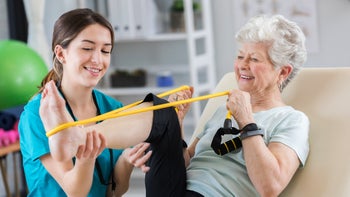
Does Medicare Cover Stair Lifts?
Key takeaways:
Original Medicare does not cover stair lifts but will pay for other types of mobility equipment, such as wheelchairs, walkers, scooters, and canes.
Medicare supplement insurance known as Medigap plans only pay for out-of-pocket costs related to items and services covered by original Medicare.
Your Medicare Advantage plan may cover a stair lift, or you may be able to save money by renting or purchasing a preowned stair lift instead of a new one.
Table of contents

A stair lift is a mobility assistance device that allows a person to navigate stairs by sitting in a chair that moves along a track. Stair lifts can support older individuals who wish to age in place and help people with disabilities remain in their homes.
Buying and installing a stair lift in your home can cost anywhere from $2,000 to more than $15,000, depending on your needs. Original Medicare does not cover stair lifts. Your Medicare Advantage plan may cover all or part of this home modification if it is deemed medically necessary.
Does Medicare cover stair lifts?
No. Original Medicare does not cover stair lifts. Under current Medicare policy, stair lifts are viewed as home modifications and not durable medical equipment like other mobility aids. That means stair lifts are not eligible for coverage. As mentioned, stair lifts may be included in your benefits if you have a Medicare Advantage plan.
Prescription Savings Are Just the Beginning
See what other benefits you qualify for—from cashback cards to cheaper insurance.

Which insurance plans cover stair lifts?
Some Medicare Advantage and commercial health insurance plans cover stair lifts. The devices also may be covered under alternative plans, such as long-term care insurance.
Other instances in which stair lifts are sometimes covered are:
If you were injured at work, you may be able to use workers’ compensation (formerly known as workmen’s compensation) to pay for a stair lift.
If you are a veteran with a service-related disability, you may qualify for a U.S. Department of Veterans Affairs (VA) home-modification grant. In this case, a Specially Adapted Housing (SAH) grant or a Special Home Adaptation (SHA) grant may help cover the cost of a stair lift.
Some Medicaid programs, which are run by states and territories, help beneficiaries pay for home modifications, including stair lifts.
If you have original Medicare, having a Medigap plan probably won’t be helpful, because this supplement insurance typically covers only out-of-pocket costs for Medicare-approved services and equipment.
What mobility devices will Medicare cover?
Medicare Part B covers items that are considered durable medical equipment, including these mobility devices:
Canes
Commode chairs
Continuous passive motion (CPM) machines
Crutches
Hospital beds and lifts
Patient lifts used to transfer a person, such as to and from a toilet or tub
Scooters
Walkers
Read more like this
Explore these related articles, suggested for readers like you.
Unfortunately, none of these devices is designed specifically to help you go up and down stairs in the same way as a stair lift. Depending on your needs, a cane or crutches may help you navigate stairs, as an alternative to a stair lift.
What should you do if you can’t afford a stair lift?
If you can’t afford a stair lift, you have options. If you only need the stair lift for a few months during a recovery period, renting may be the most affordable option. Many companies rent standard stair lifts for as little as $300 to $500 per month or $900 to $1,500 for a three-month period. But these prices do not always include installation or a security deposit. That’s why you should shop around and compare offers from stair-lift retailers to find the best price.
If your health insurance does not cover a stair lift, you may consider options such as:
Renting a stair lift
Purchasing a used stair lift
Taking out a no-interest or forgivable loan, both of which are available in some areas
Getting grants, which do not have to be repaid
Contacting a nonprofit organization that acquires and installs stair lifts at no charge
In addition, there are a variety of financing options for stair lifts. Most stair-lift retailers offer monthly payment options.
There also may be a charitable organization in your area that can help you find a free or affordable stair lift. For instance, Stairlifts for Vets provides free devices to disabled veterans living in Minnesota, Pennsylvania, and Wisconsin.
Home-modification loans and grants
There also are government programs that can help eligible individuals afford stair lifts. For instance, Massachusetts has a zero-interest home-modification loan program with deferred repayment upon property sale or title transfer to increase accessibility for people with physical limitations. As mentioned earlier, veterans with service-related disabilities may qualify for a VA home-modification grant.
Federal and local home-modification financing and assistance programs
The U.S. Department of Housing and Urban Development (HUD) has programs that offer loans and grants to help homeowners make improvements. You can start by contacting the HUD field office closest to you.
Below are links to HUD home-modification programs and other resources by state, as well as information for Washington, D.C., Puerto Rico, and the U.S. Virgin Islands.
Alaska — which also has the Alaska Housing Finance Corporation’s Senior Access Program
Colorado — which also has the Denver-area Home Builders Foundation, which assists people with home modifications, including stair lifts, in an eight-county area and accepts stair-lift donations.
District of Columbia (Washington, D.C.) — which also has the Safe at Home program, providing home adaptations that reduce the risk of falls to lower-income adults ages 60 and older and those with disabilities
Iowa — which also has organizations, including Able Up Iowa, that offer affordable, no-interest, and forgivable loans for home modifications to people with disabilities
Kentucky — which also has the Hart-Supported Living Program, which provides funding for home modifications to support residents with disabilities
Maine — which also has a Maine State Housing Authority program that provides home-modification grants for low-income homeowners with disabilities and physical challenges
Maryland — which also has a state program that provides older adults with no-interest loans for home modifications that improve accessibility
Massachusetts — which also has a state program that provides no-interest home-modification loans for adults and parents of children with disabilities
Michigan — which also has the Children with Special Needs Fund, a state program that makes disbursements when funds are available, that provides stair lifts for people under age 21 who have special healthcare needs
Minnesota — which is also in the service area of Stairlifts for Vets
Nebraska — which also has a state program to help pay for home modifications for adults and children who have Medicaid coverage
Pennsylvania — which also has 0% loan programs to finance stair lifts from the Pennsylvania Assistive Technology Foundation, and the Pennsylvania Housing Finance Agency, which provides mortgage loans to new homeowners for assistive upgrades; Pennsylvania is also in the service area of Stairlifts for Vets
Vermont — which has the Vermont Center for Independent Living’s Sue Williams Freedom Fund, which provides financial resources to people with disabilities
Wisconsin — which is also in the service area of Stairlifts for Vets
When do you need a stair lift?
You need a stair lift when it becomes unsafe for you to navigate stairs at home on your own. For many people, it is more practical to figure out how to live on one level of their home than to buy a stair lift. If that’s not an option for you, you may need a stair lift and other home modifications to remain in place.
What is the average cost of a stair lift?
Stair lift prices range from about $2,000 to more than $15,000, depending on the type of staircase. The average cost of a stair lift in 2023 was $6,000.
The bottom line
Original Medicare does not cover stair lifts, but some Medicare Advantage and commercial insurance plans do. The cost of a stair lift ranges from about $2,000 to $15,000 or more.
If you are a veteran, an older adult, or a person with a disability, you may qualify for a loan or grant to modify your home with a stair lift. You also may be able to finance a new stair lift, rent a device, or buy a used one to reduce your costs. There are also charitable organizations such as Stairlifts for Vets that provide and install stair lifts for eligible individuals.
Why trust our experts?


References
CMS.gov. (n.d.). Patient lifts – policy article.
Flannery, K., et al. (2023). How much does a stair lift cost to install? Bob Vila.
Home Advisor. (2024). How much do stair or chair lifts cost?
Hoveround. (n.d.). Stair lift questions.
Mass.gov. (n.d.). Home Modification Loan Program (HMLP).
Medicare.gov. (n.d.). Durable medical equipment (DME) coverage.
Options HME. (n.d.). Are stair lifts covered by Medicare?
Paying for Senior Care. (n.d.). Medicaid, home modifications & assistive technology: Benefits & eligibility.
Stairlifts for Vets. (n.d.). Installation areas.
Stannah. (n.d.). Medicare and Medicaid coverages for stairlifts.
U.S. Department of Housing and Urban Development. (n.d.). Home improvements.
U.S. Department of Labor. (n.d.). Workers’ compensation.
U.S. Department of Veterans Affairs. (2023). Disability housing grants for veterans.




























